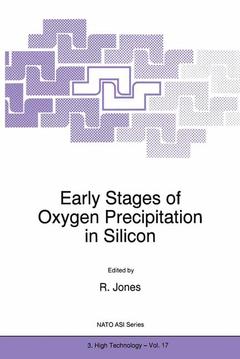Preface. Oxygen-Related Defects in Silicon: Studies Using Stress-Induced Alignment; G.D. Watkins. The Initial Stages of Oxygen Aggregation in Silicon: Dimers, Hydrogen and Self-Interstitials; R.C. Newman. Infrared Studies of the Early Stages of Oxygen Clustering in Silicon; J.L. Lindström, T. Hallberg. Magnetic Resonance Investigations of Thermal Donors in Silicon; C.A.J. Ammerlaan, et al. Magnetic Resonance on Heat Treatment Centres in Silicon; J.-M. Spaeth. Effect of Hydrogen on Oxygen-Related Defect Reactions in Silicon at Elevated Temperatures; V.P. Markevich, et al. Passivation of Thermal Donors by Atomic Hydrogen; J. Weber, D.I. Bohne. Oxygen-Carbon, Oxygen-Nitrogen and Oxygen-Dimer Defects in Silicon; C.P. Ewels, et al. The Role of Trivalent Oxygen in Electrically Active Complexes; P. Deák. Hydrogen-Oxygen Interactions in Silicon; S.K. Estreicher, et al. Oxygen Diffusion in Silicon: The Influence of Hydrogen; M. Ramamoorthy, S.T. Pantelides. Generation of Thermal Donors, Nitrogen-Oxygen Complexes and Hydrogen-Oxygen Complexes in Silicon; M. Suezawa. The Electronic Structure of the Oxygen Donor in Silicon from Piezospectroscopy; M. Stavola. Low Temperature Diffusion and agglomeration of Oxygen in Silicon; U. Gösele, et al. Roles of Structural Defects and Contaminants in Oxygen Precipitation in Silicon; K. Sumino. Various Forms of Isolated Oxygen in Semiconductors; B. Pajot. Oxygen- Related Luminescence Centres Created in Czochralski Silicon; E.C. Lightowlers, G. Davies. The Nitrogen-Pair Oxygen Defect in Silicon; F. Berg Rasmussen, et al. Thermal Double Donors in Silicon: A New Insight into the Problem; L.I. Murin, V.P. Markevich. Interaction of Positrons with Vacancy-Oxygen Complexes and OxygenClusters in Silicon; M. Fujinami. Formation of Thermal Donors in Czochralski Grown Silicon under Hydrostatic Pressure up to 1GPa; V.V. Emtsev, et al. Complexes of Oxygen and Group II Impurities in Silicon; E. McGlynn, et al. Copper and Oxygen Precipitation During Thermal Oxidation of Silicon: a TEM and EBIC Study; A. Correia, et al. Computer Simulated Distribution of Defects Formed During Cz-Si Crystal Growth; K. Kawakami, et al. A Small Angle Neutron Scattering Study of Oxygen Precipitation in Silicon; R.J. Stewart, et al. Atomic Composition, Structure and Vibrational Excitation of Substitutional Carbon-Oxygen Complexes in Silicon; H. Yamada-Kaneta, et al. Influence of Isovalent Doping on the Processes of Thermal Donors Formation in Silicon; L.I. Khirunenko, et al. Some Properties of Oxygen-Related Radiation Induced Defects in Silicon and Germanium; L.I. Khirunenko, et al. Defect Profiling of Oxygen-Related Defects Using a Slow Positron Beam; A.P. Knights, et al. Shallow N-O Donors in Silicon; A. Gali, et al. The C-Si-O-Si(.C) four-Member Ring and the Si-G15 Centre; L.C. Snyder, et al. Kinetics of Oxygen Loss and Thermal Donor Formation in Silicon: The Rapid Diffusion of Oxygen Clusters; S.A. McQuaid, et al. Molecular Dynamics Study of Oxygen Defects in Silicon; P.J. Grönberg, et al. A Kinetic Model for Precipitation of Oxygen in Silicon; S. Senkader, G. Hobler. Oxygen Gettering and Thermal Donor Formation at Post-Implantation Annealing of Silicon; A.G. Ulyashin, et al. Carbon-Hydrogen-Oxygen Related Centre Responsible for the I-Line Luminescence System; J.E. Gower, et al. Luminescence Investigations of the Interaction of Oxygen with Dislocations in Cz Si; V. Higgs. An Isochronal Annealing Study of the Kinetics of VO and VO2




